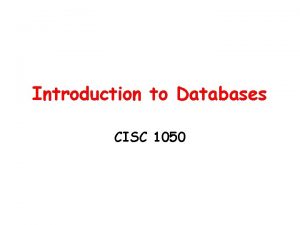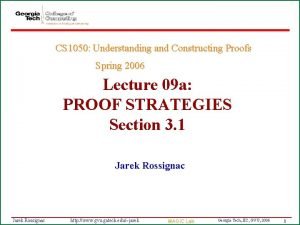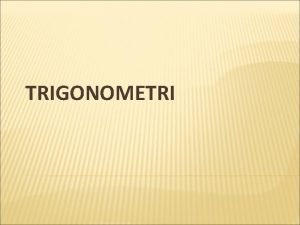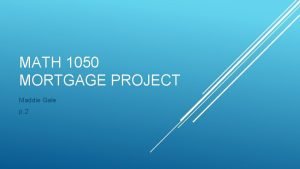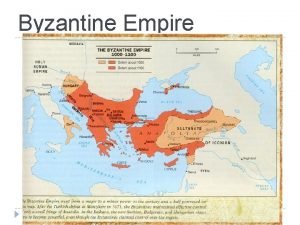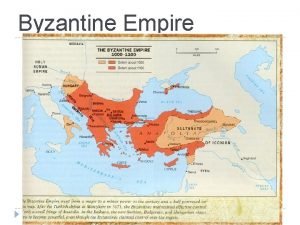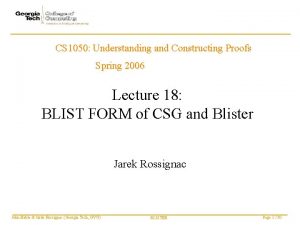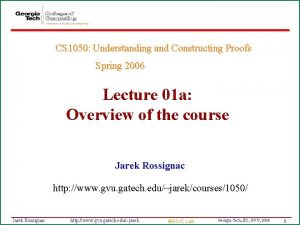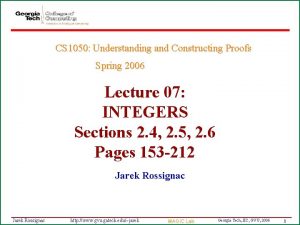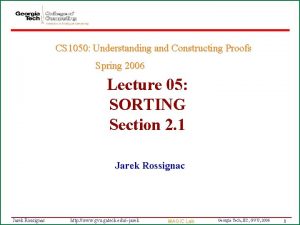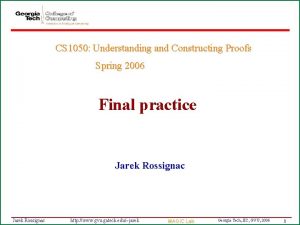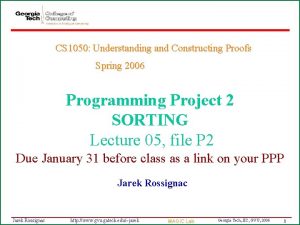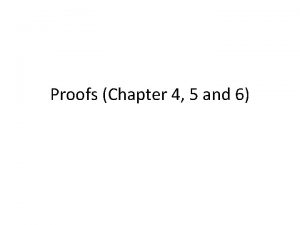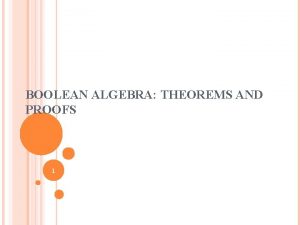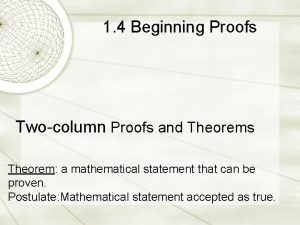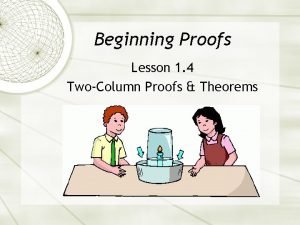CS 1050 Understanding and Constructing Proofs Spring 2006













- Slides: 13

CS 1050: Understanding and Constructing Proofs Spring 2006 Lecture 09 a: PROOF STRATEGIES Section 3. 1 Jarek Rossignac http: //www. gvu. gatech. edu/~jarek MAGIC Lab Georgia Tech, IIC, GVU, 2006 1

Lecture Objectives • Learn techniques for constructing proofs Jarek Rossignac http: //www. gvu. gatech. edu/~jarek MAGIC Lab Georgia Tech, IIC, GVU, 2006 2

How to cook 3 steaks? • You have 3 steaks. • Each one must be cooked for 1 mns on each side. • The pan can hold only 2 steaks. • Find the most time-effective strategy • Prove that it works • Prove that it is optimal Jarek Rossignac http: //www. gvu. gatech. edu/~jarek MAGIC Lab Georgia Tech, IIC, GVU, 2006 3

What is forward reasoning? To prove an implication • Start from the hypothesis • Build a chain of implications that use the know axioms to lead to the conclusion Difficulty • The path may not be obvious Jarek Rossignac http: //www. gvu. gatech. edu/~jarek MAGIC Lab Georgia Tech, IIC, GVU, 2006 4

What is backward reasoning? • Start with the conclusion. • Build a chain of implications that use the know axioms backwards – First the one that leads to the conclusion – Then one that leads to this one… • Until you get to the hypothesis Jarek Rossignac http: //www. gvu. gatech. edu/~jarek MAGIC Lab Georgia Tech, IIC, GVU, 2006 5

What is indirect reasoning? To prove an implication, • Start the negation of the conclusion • Build a chain of implications that use the know axioms to lead to the negation of the hypothesis Jarek Rossignac http: //www. gvu. gatech. edu/~jarek MAGIC Lab Georgia Tech, IIC, GVU, 2006 6

How to win at Nim with 1 pile • • Pile of 15 stones. Each player removes 1, 2, or 3 stones from the pile. The person removing the last stone wins. Is there a winning strategy for player 1? Hint: Prove that if player 2 has to pick from a pile of 4, then player 1 will win. Use backward reasoning to prove this for different (suitable) starting conditions. What should be the first move of player 1? Jarek Rossignac http: //www. gvu. gatech. edu/~jarek MAGIC Lab Georgia Tech, IIC, GVU, 2006 7

What are conjectures? • You do not know whether a conjecture is true. • Hence, you may try both proving it and looking for a counterexample. • Example: p(n)=n 2+n+41, n N p(n) is prime (Euler 1772) – N = {natural numbers, 0, 1, 2, 3…. } – Prime: integer >1 and only divisible by itself and 1 (only 2 factors) – Positive integer = product of primes (increasing order: canonical) • It works! – p(0)=41, p(1)=34, p(2)=47. P(3)=53…p(39)=1601 are all prime! • Does it? (Proof of contrary by counterexample) – p(40)=402+40+41= 402+2 40+1=(40+1)2 =1681 is not prime Jarek Rossignac http: //www. gvu. gatech. edu/~jarek MAGIC Lab Georgia Tech, IIC, GVU, 2006 8

Why are open problems important? • They inspire research and sometimes lead to new branches in mathematics. • Example of Fermat’s last theorem: The equation xn+yn = zn with integers x, y, z, n has no solution for n>2. Note that for n=2, we have Pythagorean triplets (3, 4, 5) Fermat claimed to have a proof. None could be found for about 300 years. Andrew Wiles developed a complex proof in 1990. • Goldbach conjecture: Every even integer larger than 3 is the sum of two primes. Checked up to 1014 No proof or counterexample found yet! Jarek Rossignac http: //www. gvu. gatech. edu/~jarek MAGIC Lab Georgia Tech, IIC, GVU, 2006 9

What is the halting problem An example of an unsolvable problem, Let H(P, I) be a program which takes as input any program P and the input data I for P and returns true if P(I) is guaranteed to stop and false otherwise. Alan Touring has proven in 1936 that no such H exists. Proof by contradiction: Assume H exists. Make a program K(P) which loops forever if H(P, P) and halts otherwise. Consider K(K). If H(K, K) then K(K) loops forever, but H(K, K) indicates that it halts (contradiction). If !H(K, K) then K(K) halts, but !H(K, K) indicates that it loops forever (contradiction). Conclusion, H does not exist. Jarek Rossignac http: //www. gvu. gatech. edu/~jarek MAGIC Lab Georgia Tech, IIC, GVU, 2006 10

Assigned Reading • 3. 1 Jarek Rossignac http: //www. gvu. gatech. edu/~jarek MAGIC Lab Georgia Tech, IIC, GVU, 2006 11

Assigned Exercises for the quiz • Page 223 -224: 1, 2, 20. • 2: n=1+2 k then n 2 mod 8=1 – Hint: direct proof… develop n 2 Jarek Rossignac http: //www. gvu. gatech. edu/~jarek MAGIC Lab Georgia Tech, IIC, GVU, 2006 12

Assigned Project Jarek Rossignac http: //www. gvu. gatech. edu/~jarek MAGIC Lab Georgia Tech, IIC, GVU, 2006 13
 Unknown angle proofs-proofs with constructions
Unknown angle proofs-proofs with constructions Unknown angle proofs
Unknown angle proofs Kim ki duk spring summer fall winter
Kim ki duk spring summer fall winter Spring is what months
Spring is what months Mawlid proof
Mawlid proof Cisc 1050
Cisc 1050 Kennel dosso dossi
Kennel dosso dossi Cs 1050
Cs 1050 Nilai cosinus sudut c adalah
Nilai cosinus sudut c adalah Math 1050 mortgage project
Math 1050 mortgage project Byzantine empire 1050
Byzantine empire 1050 Accomplishments of the byzantine empire
Accomplishments of the byzantine empire Nilai sin 315° adalah
Nilai sin 315° adalah The art and science of designing and constructing building
The art and science of designing and constructing building





